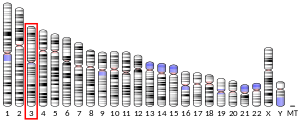P2RY14
P2Y purinoceptor 14 is a protein that in humans is encoded by the P2RY14 gene.[5]
The product of this gene, P2Y14 belongs to the family of G-protein coupled receptors, which contains several receptor subtypes with different pharmacological selectivity for various adenosine and uridine nucleotides. This receptor is a P2Y purinergic receptor for UDP-glucose and other UDP-sugars coupled to G-proteins. It has been implicated in extending the known immune system functions of P2Y receptors by participating in the regulation of the stem cell compartment, and it may also play a role in neuroimmune function. Two transcript variants encoding the same protein have been identified for this gene.[5]
See also
References
- GRCh38: Ensembl release 89: ENSG00000174944 - Ensembl, May 2017
- GRCm38: Ensembl release 89: ENSMUSG00000036381 - Ensembl, May 2017
- "Human PubMed Reference:". National Center for Biotechnology Information, U.S. National Library of Medicine.
- "Mouse PubMed Reference:". National Center for Biotechnology Information, U.S. National Library of Medicine.
- "Entrez Gene: P2RY14 purinergic receptor P2Y, G-protein coupled, 14".
Further reading
- Gerard C, Gerard NP (1994). "C5A anaphylatoxin and its seven transmembrane-segment receptor". Annu. Rev. Immunol. 12: 775–808. doi:10.1146/annurev.iy.12.040194.004015. PMID 8011297.
- Müller CE (2003). "P2-pyrimidinergic receptors and their ligands". Curr. Pharm. Des. 8 (26): 2353–2369. doi:10.2174/1381612023392937. PMID 12369950.
- Abbracchio MP, Boeynaems JM, Barnard EA, et al. (2003). "Characterization of the UDP-glucose receptor (re-named here the P2Y14 receptor) adds diversity to the P2Y receptor family". Trends Pharmacol. Sci. 24 (2): 52–55. doi:10.1016/S0165-6147(02)00038-X. PMID 12559763.
- von Kügelgen I (2006). "Pharmacological profiles of cloned mammalian P2Y-receptor subtypes". Pharmacol. Ther. 110 (3): 415–432. doi:10.1016/j.pharmthera.2005.08.014. PMID 16257449.
- Brunschweiger A, Müller CE (2006). "P2 receptors activated by uracil nucleotides--an update". Curr. Med. Chem. 13 (3): 289–312. doi:10.2174/092986706775476052. PMID 16475938.
- Nomura N, Miyajima N, Sazuka T, et al. (1995). "Prediction of the coding sequences of unidentified human genes. I. The coding sequences of 40 new genes (KIAA0001-KIAA0040) deduced by analysis of randomly sampled cDNA clones from human immature myeloid cell line KG-1". DNA Res. 1 (1): 27–35. doi:10.1093/dnares/1.1.27. PMID 7584026.
- Nomura N, Miyajima N, Sazuka T, et al. (1995). "Prediction of the coding sequences of unidentified human genes. I. The coding sequences of 40 new genes (KIAA0001-KIAA0040) deduced by analysis of randomly sampled cDNA clones from human immature myeloid cell line KG-1 (supplement)". DNA Res. 1 (1): 47–56. doi:10.1093/dnares/1.1.47. PMID 7584028.
- Charlton ME, Williams AS, Fogliano M, et al. (1997). "The isolation and characterization of a novel G protein-coupled receptor regulated by immunologic challenge". Brain Res. 764 (1–2): 141–148. doi:10.1016/S0006-8993(97)00438-1. PMID 9295203.
- Joensuu T, Hämäläinen R, Lehesjoki AE, et al. (2000). "A sequence-ready map of the Usher syndrome type III critical region on chromosome 3q". Genomics. 63 (3): 409–416. doi:10.1006/geno.1999.6096. PMID 10704288.
- Chambers JK, Macdonald LE, Sarau HM, et al. (2000). "A G protein-coupled receptor for UDP-glucose". J. Biol. Chem. 275 (15): 10767–10771. doi:10.1074/jbc.275.15.10767. PMID 10753868.
- Wittenberger T, Schaller HC, Hellebrand S (2001). "An expressed sequence tag (EST) data mining strategy succeeding in the discovery of new G-protein coupled receptors". J. Mol. Biol. 307 (3): 799–813. doi:10.1006/jmbi.2001.4520. PMID 11273702.
- Joensuu T, Hämäläinen R, Yuan B, et al. (2001). "Mutations in a Novel Gene with Transmembrane Domains Underlie Usher Syndrome Type 3". Am. J. Hum. Genet. 69 (4): 673–684. doi:10.1086/323610. PMC 1226054. PMID 11524702.
- Strausberg RL, Feingold EA, Grouse LH, et al. (2003). "Generation and initial analysis of more than 15,000 full-length human and mouse cDNA sequences". Proc. Natl. Acad. Sci. U.S.A. 99 (26): 16899–16903. doi:10.1073/pnas.242603899. PMC 139241. PMID 12477932.
- Lazarowski ER, Shea DA, Boucher RC, Harden TK (2003). "Release of cellular UDP-glucose as a potential extracellular signaling molecule". Mol. Pharmacol. 63 (5): 1190–1197. doi:10.1124/mol.63.5.1190. PMID 12695547.
- Lee BC, Cheng T, Adams GB, et al. (2003). "P2Y-like receptor, GPR105 (P2Y14), identifies and mediates chemotaxis of bone-marrowhematopoietic stem cells". Genes Dev. 17 (13): 1592–1604. doi:10.1101/gad.1071503. PMC 196132. PMID 12842911.
- Skelton L, Cooper M, Murphy M, Platt A (2003). "Human immature monocyte-derived dendritic cells express the G protein-coupled receptor GPR105 (KIAA0001, P2Y14) and increase intracellular calcium in response to its agonist, uridine diphosphoglucose". J. Immunol. 171 (4): 1941–1949. doi:10.4049/jimmunol.171.4.1941. PMID 12902497.
- Moore DJ, Murdock PR, Watson JM, et al. (2004). "GPR105, a novel Gi/o-coupled UDP-glucose receptor expressed on brain glia and peripheral immune cells, is regulated by immunologic challenge: possible role in neuroimmune function". Brain Res. Mol. Brain Res. 118 (1–2): 10–23. doi:10.1016/S0169-328X(03)00330-9. PMID 14559350.
External links
- "P2Y Receptors: P2Y14". IUPHAR Database of Receptors and Ion Channels. International Union of Basic and Clinical Pharmacology.
This article incorporates text from the United States National Library of Medicine, which is in the public domain.




